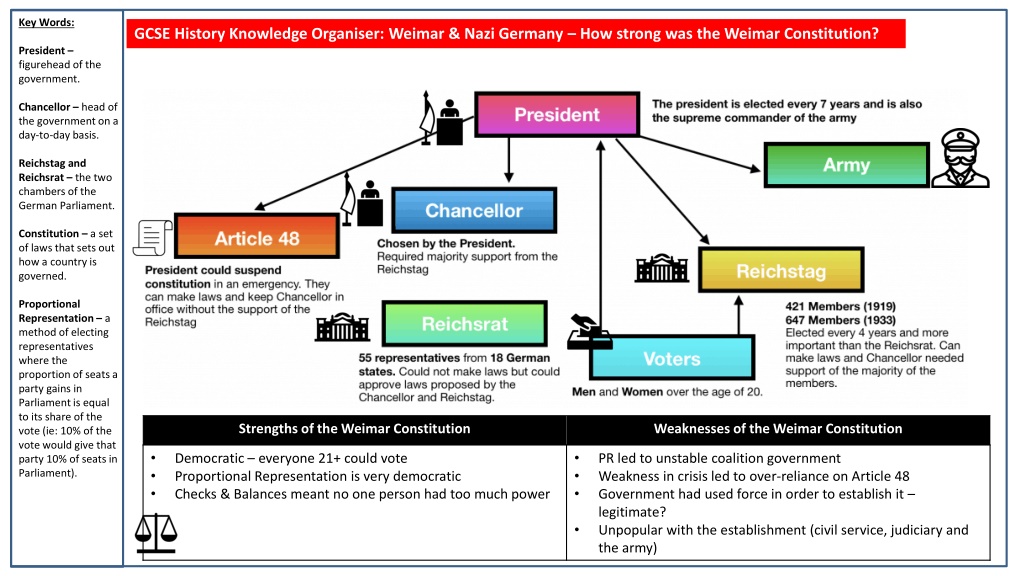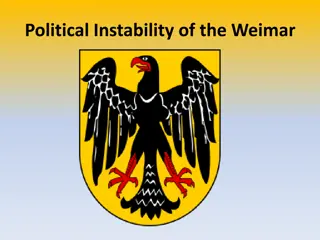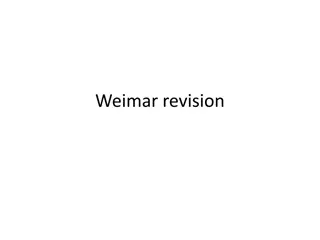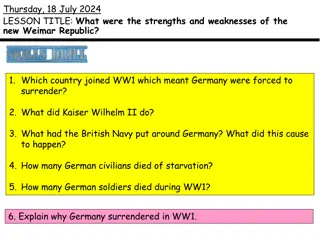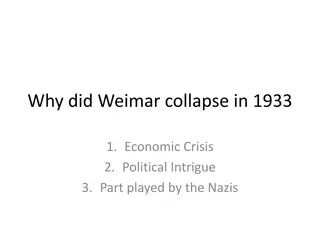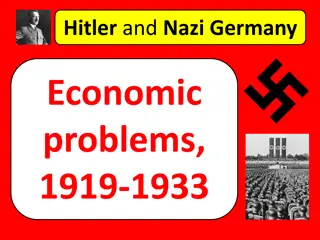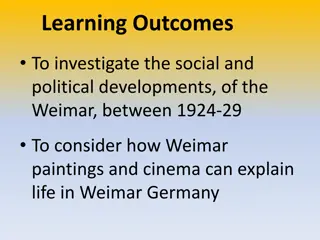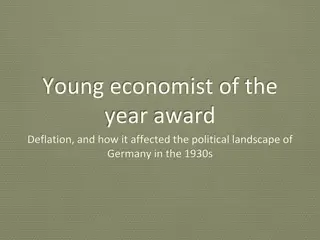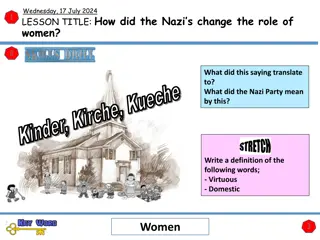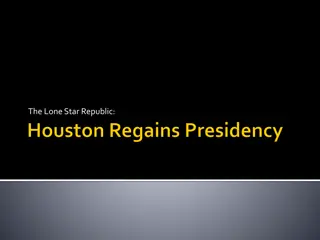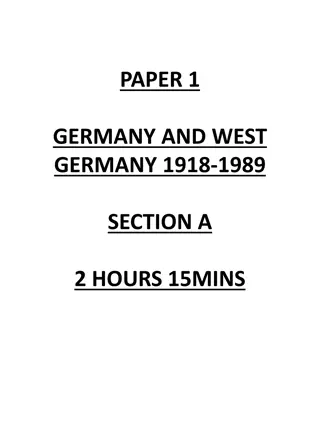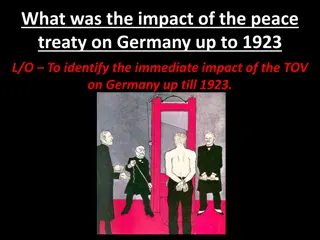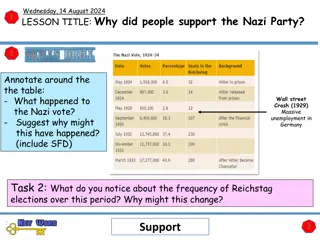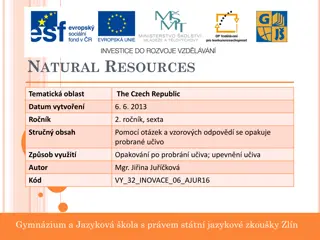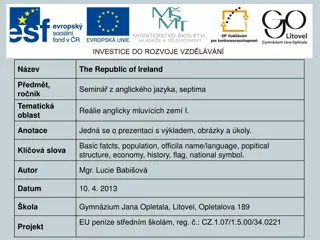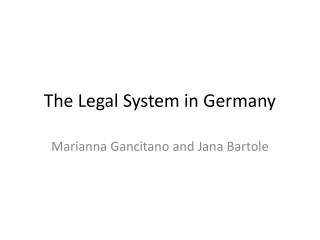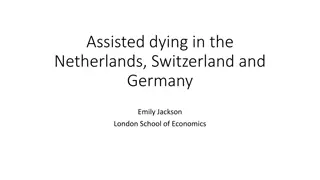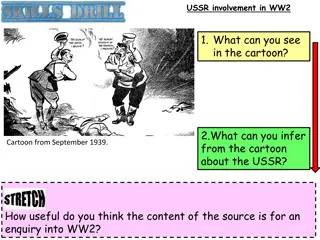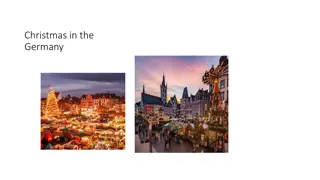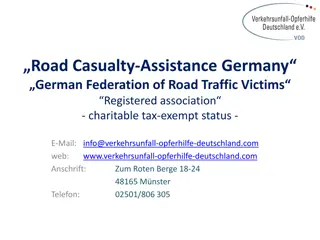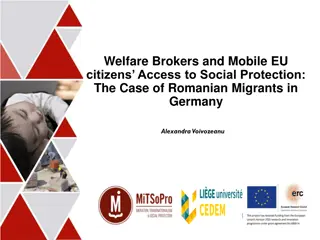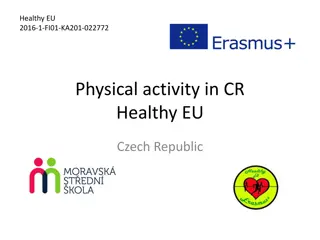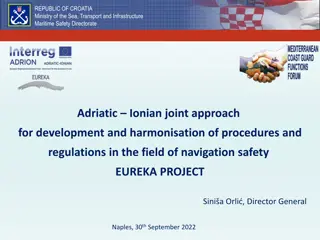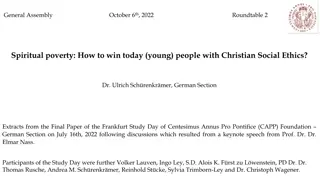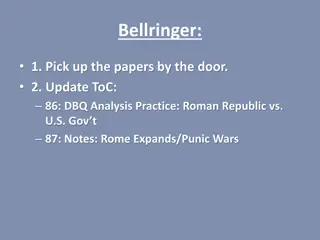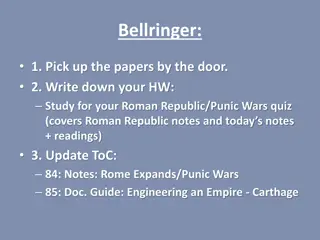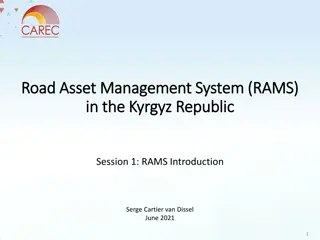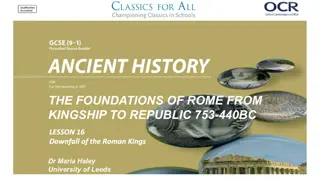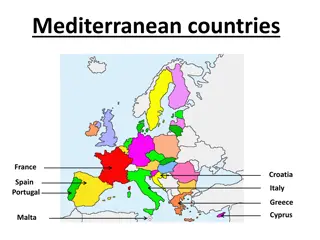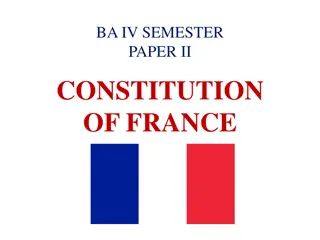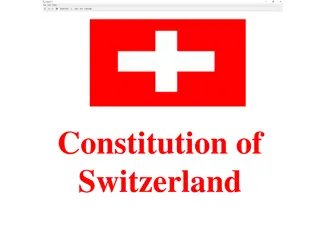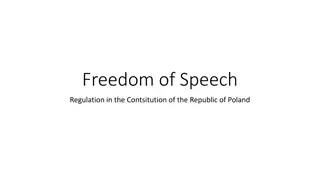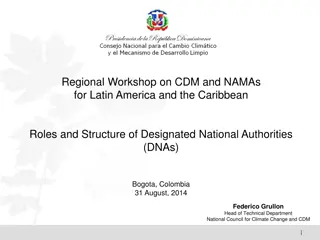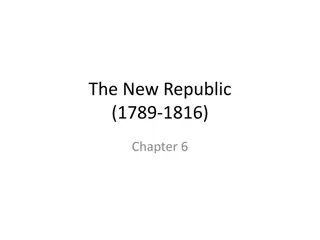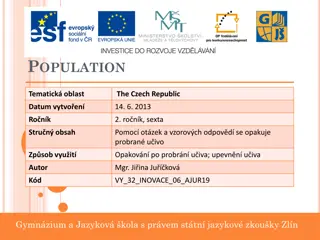Challenges Faced by the Weimar Republic in Germany
The Weimar Republic in Germany faced various challenges between 1919 and 1923, including political polarisation, extremist uprisings from both left-wing and right-wing groups such as the Spartacists and Freikorps, economic struggles like hyperinflation, and constant fighting undermining its authority.
Download Presentation

Please find below an Image/Link to download the presentation.
The content on the website is provided AS IS for your information and personal use only. It may not be sold, licensed, or shared on other websites without obtaining consent from the author. Download presentation by click this link. If you encounter any issues during the download, it is possible that the publisher has removed the file from their server.
E N D
Presentation Transcript
Key Words: GCSE History Knowledge Organiser: Weimar & Nazi Germany How strong was the Weimar Constitution? President figurehead of the government. Chancellor head of the government on a day-to-day basis. Reichstag and Reichsrat the two chambers of the German Parliament. Constitution a set of laws that sets out how a country is governed. Proportional Representation a method of electing representatives where the proportion of seats a party gains in Parliament is equal to its share of the vote (ie: 10% of the vote would give that party 10% of seats in Parliament). Strengths of the Weimar Constitution Weaknesses of the Weimar Constitution Democratic everyone 21+ could vote Proportional Representation is very democratic Checks & Balances meant no one person had too much power PR led to unstable coalition government Weakness in crisis led to over-reliance on Article 48 Government had used force in order to establish it legitimate? Unpopular with the establishment (civil service, judiciary and the army)
Key Dates: GCSE History Knowledge Organiser: Weimar & Nazi Germany Why was the Weimar Republic unpopular? 11 Nov 1918 Armistice Day The Weimar Constitution made the republic a democracy this was unpopular with the right who preferred an authoritative leader. The Treaty of Versailles imposed severe terms on Germany including Article 231 (war guilt clause) this was a humiliation for Germany. June 1919 Treaty of Versailles signed Proportional Representation led to many parties represented in the Reichstag it was therefore difficult to achieve political stability. Treaty of Versailles August 1919 Weimar Constitution formally adopted The idea that the German civilian government sought an unnecessary surrender stabbing the army in the back. Why was the Weimar Republic unpopular from the beginning? Dolchstoss ( Stab in the Back ) Criticisms of the Weimar Constitution 1923 - Hyperinflation Failure to deal with economic problems November Criminals The legacy of WWI and then hyperinflation in 1923 were issues that successive German governments struggled to deal with therefore angering many in Germany who suffered as a result. The nickname given to those members of the civilian government that signed the Treaty of Versailles.
Key Words: GCSE History Knowledge Organiser: Weimar & Nazi Germany What challenges did the Weimar Republic face from the left-wing and right-wing between 1919 and 1923? Polarisation when a country divides into two sharply contrasting sets of beliefs. 1919-1923: Huge political divisions in Germany between left- and right-wing groups (polarisation) extremes of both sides unhappy with the Republic. Challenges from left and right Spartacists a communist group led by Karl Liebknecht and Rosa Luxemburg. Challenges from the left Challenges from the right Wanted Germany controlled by the people. They opposed capitalism and wanted to abolish private ownership of land business. Wanted a return to strong government led by a powerful leader, and a strong army. Supported capitalism. Tended to be nationalist. Freikorps a large paramilitary group made of mostly disbanded German soldiers after WWI. Spartacist Uprising (1919) communist rising led by Luxemburg and Liebknecht defeated by the Freikorps. Kapp Putsch (1920) 5,000 Freikorps soldiers occupied Berlin and invited the Kaiser to return. Weimar Government urged people not to cooperate which led to the putsch s failure. Various communist risings across Germany including Hamburg and Saxony in 1923 Munich Putsch (1923) Hitler attempted to take over Bavarian government and then march on Berlin. Ended in failure and Hitler s arrest and trial. Attempts to establish regional socialist governments in Saxony and Thuringia Putsch a German word for an uprising. Ongoing political violence approx. 376 murders mainly carried out by the right-wring. Two leading Weimar ministers assassinated (Erzberger and Rathenau) Weimar Republic plagued by constant fighting and challenges to its authority. Moderate Reichstag parties struggled to form coalitions while being constantly attacked by extremist politicians.
Key Words: GCSE History Knowledge Organiser: Weimar & Nazi Germany Why was 1923 a crisis year for the Weimar Republic? The Ruhr an industrial region of Germany that generated lots of wealth. Reparations compensation paid by the defeated in war to the victor. 8-9 November 1923 August 1923 1923 January 1923 15 November 1923 The French Invasion of the Ruhr Passive resistance a tactic employed by Germans in the Ruhr where the workers refused to cooperate with the French and employed non- violent opposition. Munich Putsch Stresemann becomes Chancellor (until December) and Foreign Minister Rentenmark Introduced Hyperinflation An occupation of the industrial Ruhr region by French and Belgian troops took place when Germany failed to pay reparations to those countries. The strike meant less goods being produced. The extra money in circulation plus the collapse in production caused hyperinflation (money lost its value). Hitler seized on the chaos that had taken hold of Germany in 1923 and attempted to overthrow the government in Bavaria (southern Germany). In August Gustav Stresemann became both Chancellor and Foreign Minister. By November 1923 the value of the German mark had been destroyed. Stresemann introduced a temporary currency the Rentenmark which was based on property values. This aimed to restore confidence in German currency. Hyperinflation rapid and uncontrollable devaluation of currency leading to huge price rises. His government would collapse by November but he continued on as Foreign Minister until his death in 1929, playing a big role in securing American help in Weimar s recovery. Occupation was met with passive resistance with the German workers going on strike. People with savings or those on a fixed income found themselves penniless. The putsch was foiled and Hitler was arrested and tried for treason. However the trial gained Hitler publicity nationwide. Rentenmark a temporary currency introduced in Germany to replace the old papiermark. After approximately a year the Rentenmark was converted into the Reichsmark, a new currency backed by gold reserves. After this, the republic began to see the signs of recovery. To support the strikers, the government printed more money to pay them a wage. In November 1923, 1 = one-thousand, six- hundred and eighty trillion marks. 1,680,800,000,000,000
Key Dates: Nov 1923 Introduction of the Rentenmark GCSE History Knowledge Organiser: Weimar & Nazi Germany Why did the Weimar Republic recover after 1923? Although Stresemann was only Chancellor for a few months of 1923, in that time he introduced the Rentenmark which ended hyperinflation. Stresemann played a role in negotiating several agreements with the USA to help recovery: Sept 1924 Dawes Plan goes into effect Dawes Plan (1924) reparations would begin at 1bn marks and increase to 2.5bn marks per year over the following four years. The USA would loan 800m marks to Germany plus another $3bn by 1929. Between 1923-29, as Foreign Minister, he was instrumental in regaining Germany s place on the world stage and helping the economy to recover 1924 Reichsmark introduced as Germany s new permanent currency Role of Gustav Stresemann as Foreign Minister Young Plan (1929) reparations reduced to 1.85bn and Germany given 59 years to pay the amount an average of 2.05bn marks per year. The economic recovery coupled with successes abroad led to growing political stability after 1924. Support for moderate parties grew whilst support for extremist parties dwindled. Furthermore the election of WWI hero Hindenburg as President in 1925 seemed to show the old conservative establishment now accepted the Weimar Republic. Why did the Weimar Republic recover after 1923? 1925 Locarno Pact Growing Political Stability American Assistance 1925 Hindenburg elected President Locarno Pact (1925) agreement with Britain, France, Belgium and Italy to keep existing borders between Germany, Belgium and France. Began a period of cooperation between the European powers. 1926 Germany joins the League of Nations Currency Reform Ended Hyperinflation Foreign Policy Achievements 1927 Allied troops withdrew from the west bank of the Rhine, five years early. Germany joins League of Nations (1926) Germany given a permanent seat on the Council. In November 1923 Stresemann introduced a temporary currency the Rentenmark which was based on property values. After approximately a year the Rentenmark was converted into the Reichsmark, a new currency backed by gold reserves. As a result hyperinflation came to an end. Kellogg-Briand Pact (1928) agreement with 64 other nations to use armies for self-defence only and solve all international disputes by peaceful means. 1929 Young Plan agreed
Key Words: GCSE History Knowledge Organiser: Weimar & Nazi Germany How far did Weimar German society change for the better? Unemployment Insurance Act (1927) a scheme where employers and employees paid into a scheme which provided money if a person became unemployed or sick. How far did Weimar German society change for the better? Standard of Living Women Culture Evidence of improvement Evidence of little change Evidence of improvement Evidence of little change Evidence of improvement Evidence of little change Weimar Constitution introduced votes for women over 20, equality in education, equal pay in the professions. Proportion of women in work remained largely unchanged compared to pre-war levels 36% in 1925. Increase in real wages of over 10% by 1928 (on average) which mainly benefitted the working classes. Middle-classes saw little benefit did not experience a noticeable rise in wages Strict pre-war censorship on art was removed and government provided financial support. Therefore: There were some reactionary attitudes still prevalent in Germany. Some, largely on the political right, criticised these changes and believed they seriously weakened German society and values. For these people, cultural changes only increased their opposition to the Weimar Republic. Neue Sachlichkeit New Objectivism held that the arts should show life as it really is. Weimar artists try to portray everyday life in their paintings (Neue Sachlichkeit) Grosz and Dix. By 1926 there were 32 female deputies in the Reichstag. After WWI, the better paid jobs were largely reclaimed by men coming back from the war. Unemployment generally fell (only 1.3m by 1928) Unemployment still high in the professions. 184,000 unemployed middle- class workers in Apr 1928 Bauhaus a movement that stressed the beauty in technology, simple lines and careful craftsmanship. Used basic shapes and colours. 2m new homes built 1924- 1931 Growing number of women in new areas of employment and public services (civil service, teaching, etc). By 1933 there were 100,000 women teachers and 3,000 women doctors. Bauhaus architecture flourished. By 1928 homelessness reduced by more than 60%. Attitudes did not change much married women in work ( double- earners ) often criticised for neglecting their homes. Golden age for German cinema. Fritz land produced the film Metropolis (1926). The government extended the reforms introduced by Bismarck in the 1880s by introducing the Unemployment Insurance Act (1927). There were discussions about war in 1920s German literature. Remarque wrote All Quiet on the Western Front (1929). Reactionary conservative;, opposing political or social progress or reform Women enjoyed more social freedom, going out unescorted, able to drink and smoke in public. Emergence of Zeittheater and Zeitoper
Key Words: Nationalism political ideas that emphasise the importance of the nation. GCSE History Knowledge Organiser: Weimar & Nazi Germany How did the Nazi Party develop under Hitler, 1919-29? September 1919 Hitler joins the German Workers Party (DAP) November 1923 Hitler leads the failed Munich Putsch How did Hitler establish his leadership of the NSDAP by 1923? How did Hitler develop the NSDAP during the Lean Years (1924-29)? Socialism political idea that all people are equal and should share in a country s wealth. Party Policy Twenty-Five Point Programme Ideas in Mein Kampf form basis of Nazi policy Hitler realised he needed a new strategy needed to build legitimate national support Volkischer Beobachter the Nazi newspaper, People s Observer Hitler s Personal Appeal Party HQ based in Munich Hitler used his time in prison to write Mein Kampf the book that became the inspiration of the Nazi Party Sturmabteiling (SA) the Nazi s paramilitary group made of largely ex-soldiers and students. They dressed in brown shirts. Creation of a national Nazi Party Party Organisation Party Expansion of the SS to 3,000 Hitler s trial earned him national publicity for his views Leadership Schutzstaffel (SS) - a paramilitary group that acted as Hitler s bodyguard. They dressed in black uniform. The Bamberg Conference (1926) shifts the NSDAP towards nationalism The SA (Brownshirts)
Key Words: GCSE History Knowledge Organiser: Weimar & Nazi Germany Why did support for the Nazis grow after 1929? KPD The German Communist Party German banking system collapsed. Banks recalled loans from German businesses, leading to a collapse of the German economy. This led to widespread unemployment approx. 5m by 1932. Successive governments failed to deal with this problem. Although Hindenburg defeated Hitler, it ensured that Hitler was recognised as a national political figure because he used modern campaigning strategies such as flying between cities to give speeches. This contributed to greater success in the Reichstag elections of July 1932. Industrialists wealthy factory owners As the government failed to deal with unemployment, German voters switched to extremist parties like the NSDAP and KPD. Propaganda - information, especially of a biased or misleading nature, used to promote a political cause or point of view. Impact of the Wall Street Crash The KPD had gained 1m extra voters by 1932 this terrified the German middle- and upper-classes who feared their land and companies would be confiscated by a communist government. As support for the KPD grew among the working class, more middle-class voters switched to the Nazis because they felt Hitler was their best defence against the communists. The Presidential Election of 1932 Rise in support for the KPD Why did support for the Nazis grow after the Wall Street Crash in 1929? Middle-class - the social group between the upper and working classes, including professional and business people and their families. Appeal of the Nazis to different sections of society Goebbels Propaganda Hitler s personal appeal The NSDAP s propaganda chief, Josef Goebbels has mastered the art of propaganda, making sure that the Nazi message was everywhere, and that Hitler was seen as a the face of the NSDAP. The Nazis had policies that appealed to particular sections of German society. This meant there was something for everyone. Support from big business in particular was key because it brought in huge amounts of money, without which Goebbels could not have conducted his nationwide propaganda campaign. In Hitler the people saw a strong leader who promised to restore law and order, and to scrap the Treaty of Versailles. His strong skills as a public speaker helped increase membership of the party.
Key Words: GCSE History Knowledge Organiser: Weimar & Nazi Germany How did Hitler establish a dictatorship, 1933-1934? Dictatorship - A dictator is a political leader who possesses absolute power. A dictatorship is a state ruled by one dictator. 288 July 1933 Feb 1933 March 1933 May 1933 March 1933 Aug 1934 Aug 1934 June 1934 Constitution the laws that set out how a country is governed. Political Parties banned Night of the Long Knives Death of Hindenburg Hitler becomes Fuhrer Trade Unions banned Reichstag Fire Army Oath Enabling Act Nazis win 288 seats in Reichstag Reichstag building burned down. A Dutch communist, van der Lubbe, caught and executed. The Night of the Long Knives had already eased some fears the army had about the SA and meant they would now support Hitler. Hitler proposed a law that would give Hitler the right to make laws for four years without the Reichstag s consent. The SA destroyed the newspapers of the SPD and KPD, and confiscated their funds in May. Hitler perceived the SA s leader, Rohm, as a rival. Rohm leaned towards the socialists aspects of National Socialism. The SA numbered 3m men who were loyal to Rohm, putting him in a position to challenge Hitler. In June 1934, Rohm and leading members of the SA were arrested and shot. The SA was now firmly under Hitler s control. Hitler believed that communists controlled the unions then they could undermine the government through strikes. The Nazis increased their Reichstag members to 288. Having banned the KPD from taking up its 81 seats, and with the support of nationalist parties, Hitler now had a crucial two-thirds majority allowing him to make constitutional changes. Trade Unions organisations that represent and defend workers interests. President Hindenburg died in August 1934. Soon after, Hitler combined the offices of Chancellor and President, making himself Fuhrer. Hitler used the fire as an opportunity to attack the communists, having 4,000 arrested. In July he issued a decree making all political parties, except the NSDAP, illegal. In May 1933, the Nazis arrested trade union officials, banned trade unions and made strikes illegal. Upon Under threatening circumstances, the Enabling Act was passed by 444 votes to 94. This marked the end of democracy in Germany and the Weimar Constitution. Decree - an official order that has the force of law Hindenburg s death, Hitler had the army swear an oath of allegiance to him personally. Hitler was now without rival as the leader of Germany. Oath a promise He then used his powers to stop the KPD taking up their 81 seats in the Reichstag. Fuhrer German word for leader. By the end of 1934, Hitler was in a very secure position because of his new title, the support of the army and the removal of opposition.
Key Words: GCSE History Knowledge Organiser: Weimar & Nazi Germany How did the Nazis control attitudes in the Third Reich? Propaganda - information, especially of a biased or misleading nature, used to promote a political cause or point of view. The Gestapo Sent people to The SS The SD Concentration camps Newspapers Judiciary the legal system: judges and courts. The Nazi Police State Judges had to be member of the National Socialist League for the Maintenance of the Law. Radio Concordat an agreement between the Nazi regime and the Pope that the Catholic Church would not interfere in German politics in return for religious freedom for Catholics in Germany. Hitler soon broke this agreement. How did the Nazis control attitudes in the Third Reich? Goebbels's Ministry of Propaganda Posters Control of the Judiciary Abolition of trial by jury and founding of the People s Court Literature Nazi Control of the Arts and Sport Nazi Policies Towards the Church Rallies Gestapo plain- clothed secret police led by Heydrich from 1936. Monumental style of buildings encouraged Art should stress romantic ideas about Germany s past Jazz banned, German folk music and music by German composers promoted. Sport encouraged. Protestant Church Catholic Church Concordat (1933) Berlin Olympics (1936) was a major showcase event. Concentration camps large prisons for political prisoners Formation of the Reich Church (1936) Catholic youth activities banned
Key Words: GCSE History Knowledge Organiser: Weimar & Nazi Germany How effective was opposition to the Nazi regime between 1933-1939? Opposition resistance or dissent to something. How effective was opposition to the Nazi regime between 1933-1939? High Command the senior staff of the army. Hitler Youth the Nazi youth organisation for boys 14-18. Membership was compulsory from 1936. The Army The Youth The Church Evidence of opposition Evidence of conformity Evidence of opposition Evidence of conformity Evidence of opposition Evidence of conformity Chief of German High Command, Ludwig Beck, resigned in protest at Hitler s plans. Plan to overthrow Hitler in 1938 abandoned after his successes in Czechoslovakia. Edelweiss Pirates copied American fashion trends and taunted Hitler Youth members. Membership of the Hitler Youth by 1939 was around 8m. Pastors Emergency League (1933) and Confessional Church (1934) set up in opposition to the Reich Church Pope Pius XI and Hitler agreed the Concordat in 1933 The League of German Maidens the Nazi youth organisation for girls 14-18. Many young people were enthusiastic and committed Hitler Youth members. Many Protestants joined the Reich Church The Swing Youth admired American culture and music. They organised illegal dances. Pastors Emergency League a group of Protestant pastors led by Martin Niemoller who opposed the treatment of Protestant churches in Germany. Pope s message, With Burning Concern, read in all Catholic Churches in 1937 Attendance of non- Reich Church services did not become open opposition There was some opposition to the Hitler and Nazi regime but it was never coordinated or unified. The young, the Church and the army did present some challenges to Hitler but they were never enough to threaten the regime in the years 1933 to 1939.
Key Terms: Curriculum what is taught in schools. GCSE History Knowledge Organiser: Weimar & Nazi Germany How did life in Germany change under the Nazis by 1939? How did life in Germany change under the Nazis by 1939? Law for the Encouragement of Marriage (1933) gave loans to help young couples marry. Young People Women Employment and Living Standards Mothers Cross a medal given to women who had a certain number of children. Bring up the young as proud Germans, make them strong and healthy, teach them to support Nazi ideas. Boys should learn to do productive work for the German economy and fight in the armed forces. Girls should learn how to be good wives and mothers. To reduce unemployment through providing work for the unemployed and expanding public works. Women should adopt a traditional role and stay at home rather than go to work. They should adopt a natural look with simple plaited hair and long skirts. The Nazis wanted women to marry and have many children to make Germany bigger and stronger. Nazi policies towards unemployment Lebensborn a programme where unmarried women could become pregnant by racially pure SS men. National Labour Service (RAD) Nazi policies towards the young Nazi policies towards women Autobahns (motorways) Hitler Youth (political, physical and military training) Law for the Encouragement of Marriage (1933) Rearmament Change in divorce laws (1938) League of German Maidens (preparation for marriage and motherhood) Rearmament when a country begins to rebuild its armed forces. Nazi policies towards living standards The Mother s Cross Strength Through Joy (KdF) & Beauty of Labour Nazi Teachers League Invisible Unemployment using dubious methods to keep unemployment figures low. Lebensborn (1935) Volkswagen Scheme Nazification of the curriculum Reduction of women in work Not all workers benefitted from Nazi policy. Unemployment figures are dubious due to invisible employment. Although many young people joined the Nazi organisations, it was not always popular with its members. As German industry grew alongside rearmament, the needs of the state brought more women back into work.
Key Words: GCSE History Knowledge Organiser: Weimar & Nazi Germany How did persecution of the Jewish people escalate? Civil Service government employees. 9-10 1938 Apr-May 1933 Apr 1933 Sept 1935 1934 1942-1945 Apr 1939 Boycott refusing to buy or take part in something as a protest. Nov 1938 Kristallnacht The Final Solution Nuremberg Laws Escalation of measures Formation of the Reich Office for Jewish Emigration Jews banned from certain jobs Growth of segregation Boycott of Jewish businesses In response to the murder of a German official by a Jew, the Nazis organised an anti- Jewish demonstration involving attacks on Jewish property, shops, homes and synagogues. The Reich Law on Citizenship stripped Jews of their citizenship and required them to wear a yellow Star of David on their clothes. Segregation keeping two groups apart. German conquests during WWII brought millions more Jews under Nazi control which led to the Final Solution (the use of death camps) from 1942 onwards. Jews had to register all of their possessions and carry identify cards. Jews could no longer work in the civil service or teaching. For one day (1st Apr) Germans were encouraged to boycott Jewish businesses. Local councils controlled by the Nazis began to ban Jews from parks and swimming pools. Others provided separate park benches for Jews. The SS became responsible for driving the Jews out of Germany through forced emigration. Synagogue the Jewish place of worship. Jews were banned from the army. The SA stood as an intimidating presence at the entrance to business premises. The Reich Law for the Protection of German Blood and Honour forbade marriage and sexual relations between Germans and Jews. Forced emigration forcing or strongly pushing people to leave a country. However the outbreak of World War II forced the Nazis to change their plans. 100 Jews were killed, 7500 businesses and 191 synagogues destroyed. The Final Solution the plan by the Nazis to exterminate Europe s Jewish population using death camps and gas chambers. Which minorities were persecuted by the Nazi regime? Jews Roma Slavs Homosexuals The Disabled Afro-Germans
